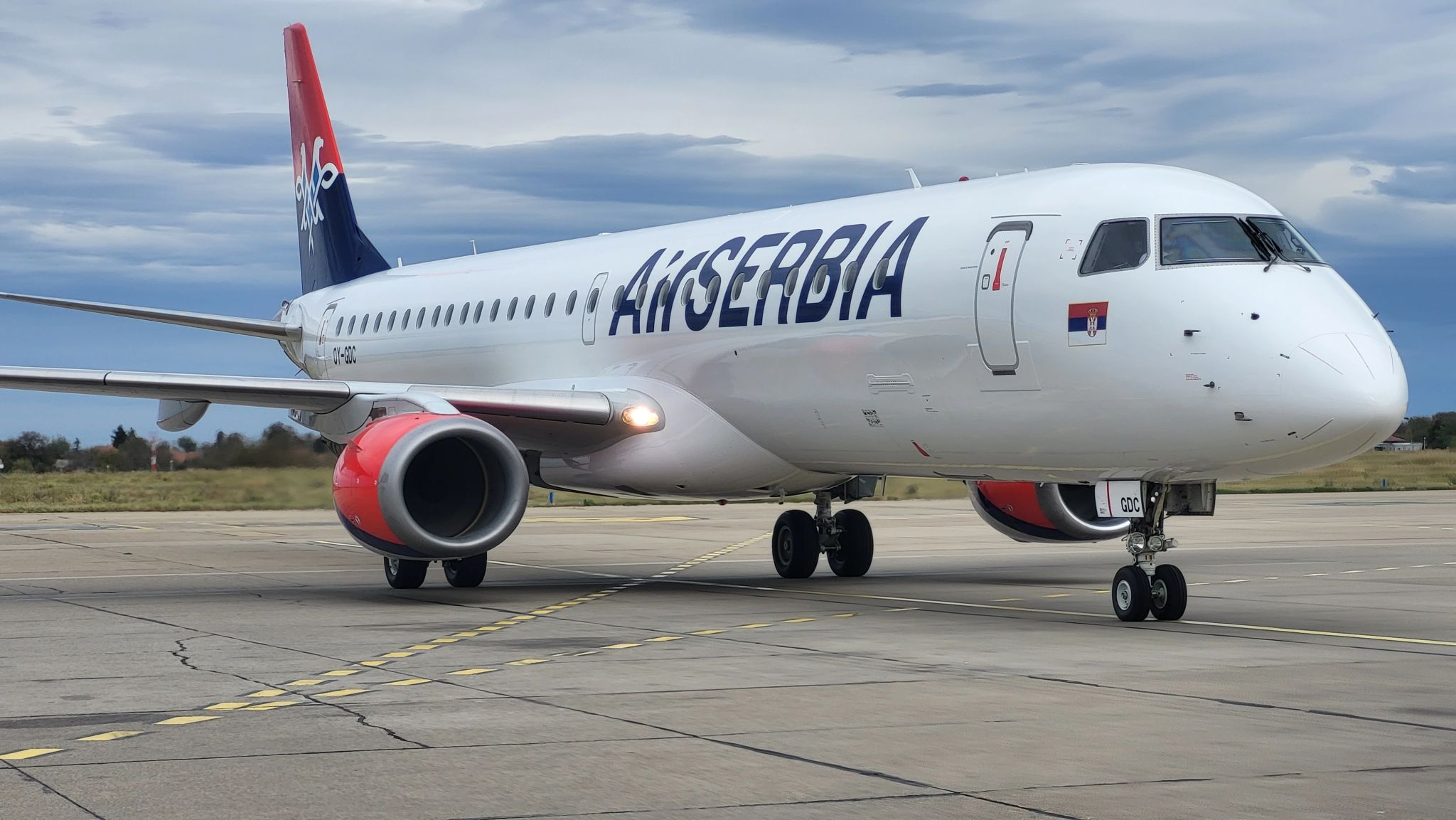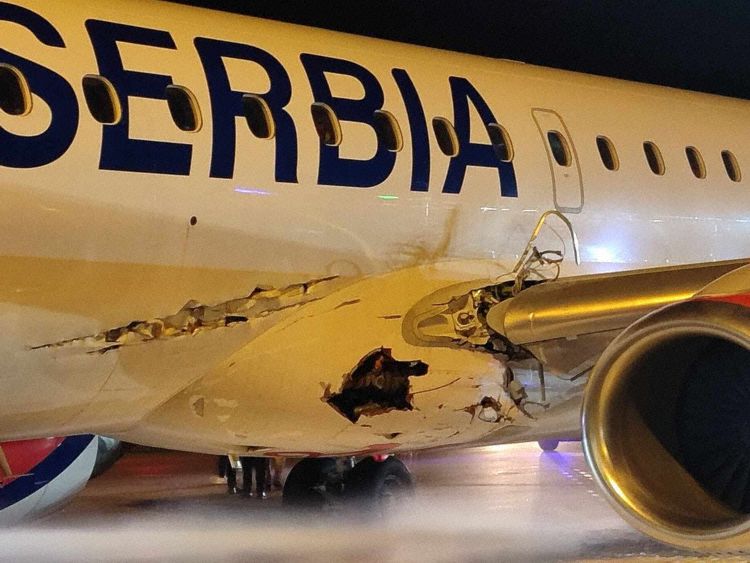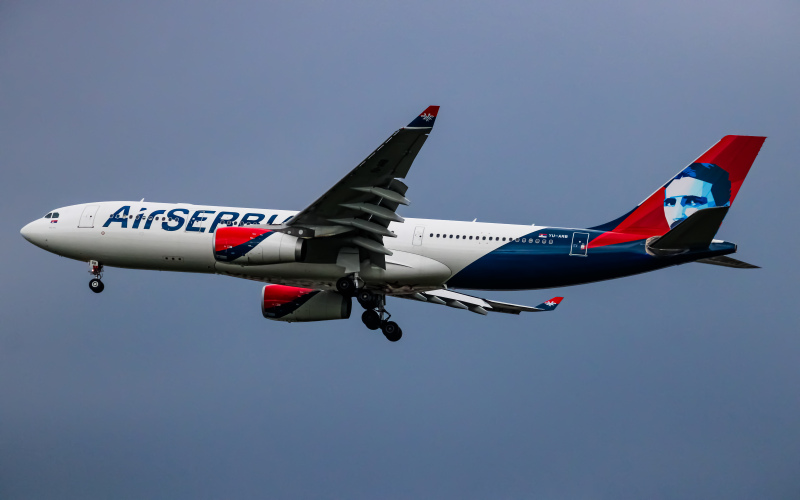An Air Serbia Embraer E195 was heavily damaged after overrunning the runway during takeoff on February 18. The aircraft was departing from Belgrade en route to Düsseldorf.

Runway Overrun
Air Serbia flight 324 (JU 324) is a regularly scheduled service from the airline's hub at Belgrade Nikola Tesla Airport (BEG) to Düsseldorf Airport (DUS) in Germany. The flight is usually operated by an Airbus A319 or Embraer E195, with the flight on February 18 using an Embraer E195LR with registration OY-GDC. JU 324 was taxiing for a relatively on-time departure shortly after 5:30 p.m. local time.
OY-GDC is almost 16 years old and one of Air Serbia's four E195s. These four planes are leased from Greek carrier Marathon Airlines. The aircraft retains its "OY" registration prefix from its previous stint flying for Great Dane Airlines, a now-defunct carrier based in Denmark.

Flightradar24 playback data shows that JU 324 lined up on Belgrade's Runway 30L for departure around 5:39 p.m. local time. However, the Marathon Airlines pilots operating the flight did not enter the runway from the correct point. It is understood that the aircraft turned onto the runway at taxiway D5, located a little less than midway down the runway.
Runway 30L/12R is 11,483 feet (3,500 meters) long. However, from where the aircraft turned onto the runway, it only had 4,175 feet (1,273 meters) left. To put this into perspective, Embraer states that an E195LR needs a minimum takeoff field length of 4,698 feet (1,432 meters) to get airborne safely. This scenario is based on the aircraft having a full load of passengers and fuel for a flight of roughly 500 nautical miles (926 kilometers).
.jpg)
A flight from Belgrade to Düsseldorf covers 768 miles or 667 nautical miles (1,235 kilometers). The minimum takeoff field lengths vary for the E195LR and E195AR models. The aircraft used for JU 342 was an E195LR. It has been understood that Belgrade's Air Traffic Control warned the pilots of Flight 324 regarding the decreased runway length. They asked the pilots twice about their intentions to take off from this point.
Given the decreased length, the aircraft overran the runway and collided with high-precision runway lights before eventually taking another 1,650 feet (503 meters) to get airborne. The collision significantly damaged the E195's fuselage, including the vertical stabilizer. After its safe return to Belgrade, photos of the aircraft show various holes and scratches in the underbelly.
.jpg)
Safe Diversion
After getting airborne, the E195 climbed to 4,000 feet (1,219 meters) and entered a holding pattern. The aircraft made a series of circuits dumping fuel before safely landing at Belgrade Airport on Runway 12L. The Air Serbia E195s have the capacity for 118 passengers. There were 106 people onboard the aircraft, all safely evacuated without major injuries. OY-GDC, the aircraft involved, has been taken out of service to receive necessary repairs.
While the damage was extensive, photos suggest it was not severe enough to force the aircraft out of service. Such instances of aircraft overrunning the runway on takeoff rolls are called runway overruns. Pilots and air traffic controllers work together to ensure the safest possible takeoff, considering the taxiways and entry points from where the aircraft will take off.
However, human error is always an inevitable factor.

While such incidents are thankfully rare, they do happen every once in a while. A similar incident to this Air Serbia flight was Qatar Airways Flight 778 in 2015. This flight, operated by a Boeing 777-300ER, struck several runway lights as it took off from Miami (MIA). Although the incident tore a gash in the fuselage, the flight continued safely to Doha (DOH).
The incident was attributed to pilot error as the pilots had taken off from the wrong intersection. This caused the 777 to only have 8,500 feet (2,591 meters) to get airborne when it should have used the full 13,000 feet (3,962) of Miami's Runway 09.
Comments (0)
Add Your Comment
SHARE
TAGS
NEWS Air Serbia Serbia Belgrade Airport Runway Incident Safety Embraer E195RECENTLY PUBLISHED
 Learjet Owned By Vince Neil Crashes Into Gulfstream Jet, 1 Fatality Confirmed
On February 10th, around 14:30 local time, a Learjet private jet aircraft crashed into another private jet after landing at Scottsdale Airport (SCF) in Arizona.
NEWS
READ MORE »
Learjet Owned By Vince Neil Crashes Into Gulfstream Jet, 1 Fatality Confirmed
On February 10th, around 14:30 local time, a Learjet private jet aircraft crashed into another private jet after landing at Scottsdale Airport (SCF) in Arizona.
NEWS
READ MORE »
 Seattle Plane Strike 2025: Japan Airlines and Delta Collision Raises Safety Concerns
Seattle-Tacoma International Airport saw a concerning incident on Wednesday morning when a Japan Airlines (JAL) plane clipped a parked Delta Air Lines jet while taxiing. Thankfully, no one was injured, but passengers described the collision as a frightening experience.
NEWS
READ MORE »
Seattle Plane Strike 2025: Japan Airlines and Delta Collision Raises Safety Concerns
Seattle-Tacoma International Airport saw a concerning incident on Wednesday morning when a Japan Airlines (JAL) plane clipped a parked Delta Air Lines jet while taxiing. Thankfully, no one was injured, but passengers described the collision as a frightening experience.
NEWS
READ MORE »
 Ethiopian Airlines Expands Cargo Fleet with New Boeing 777 Freighter
Ethiopian Airlines has expanded its cargo fleet with a brand-new Boeing 777 Freighter, registered as ET-BAB (MSN 68140). The aircraft was delivered directly from Boeing’s factory in Everett, Washington, USA, and landed at Addis Ababa Bole International Airport at 3:41 PM (GMT+3) on Wednesday, January 22, 2025.
NEWS
READ MORE »
Ethiopian Airlines Expands Cargo Fleet with New Boeing 777 Freighter
Ethiopian Airlines has expanded its cargo fleet with a brand-new Boeing 777 Freighter, registered as ET-BAB (MSN 68140). The aircraft was delivered directly from Boeing’s factory in Everett, Washington, USA, and landed at Addis Ababa Bole International Airport at 3:41 PM (GMT+3) on Wednesday, January 22, 2025.
NEWS
READ MORE »





